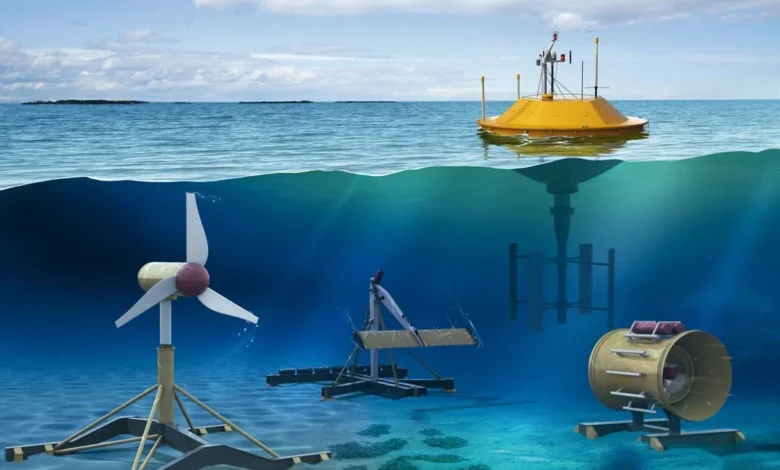Flowatt Tidal Farm Marine Tidal Energy

Flowatt Tidal Farm Marine Tidal Energy: The FloWatt tidal farm (sometimes spelled Flowatt) is emerging as one of the most ambitious tidal energy projects in Europe. Located at Raz Blanchard in Normandy, it aims to harness some of the strongest tidal currents in the world. Developed by HydroQuest in partnership with Qair and industrial partner CMN, FloWatt promises predictable, zero-carbon electricity and could help catalyze marine energy both in France and globally.
What Is the FloWatt Project? Key Facts & Capacity
FloWatt is a tidal stream farm designed to generate electricity using underwater turbines driven by marine currents. Here are its crucial specifications:
-
Location: Raz Blanchard passage, off the coast of Normandy, near Cherbourg.
-
Capacity: ~17-17.5 MW, via 7 tidal turbines of about 2.5 MW each (some reports initially said 6 turbines of 2.8 MW) manufactured by HydroQuest in partnership with Constructions Mécaniques de Normandie (CMN).
-
Depth & Distance: Turbines will be submerged (~30-35 m depth), about 3 km offshore, fully underwater so they’re invisible from the coast.
-
Electricity Output: Expected to supply enough clean electricity for around 20,000 inhabitants, over a lifespan of 20 years.
-
Timeline: Construction planned to begin around 2026, with commissioning expected by 2027-2028.
FloWatt reflects a transition from pilot demonstrators toward commercially viable, scaleable tidal energy.
Why FloWatt Matters: Benefits & Strategic Importance
FloWatt isn’t just another renewable project; its value is multi-dimensional.
1. Predictable & Renewable Energy
Unlike solar or wind, which depend on weather conditions, tidal energy is predictable: the tides follow regular, gravitational patterns. This gives grid operators certainty over generation schedules.
2. Contribution to Energy Mix & Climate Goals
FloWatt helps France (and Europe) toward carbon neutrality and energy independence, reducing reliance on fossil fuels.
3. Industrial & Local Economic Impact
The project emphasizes a local supply chain: turbines built in Cherbourg, much of the project value attributed to French industry. Expected to generate 6,000 direct & indirect jobs by 2030.
4. Technological Maturity & Replicability
FloWatt builds on prototypes and smaller scale tests (e.g. HydroQuest’s 1 MW turbine tested at Paimpol-Bréhat) which showed strong availability and reliability. The technology is designed to be replicated in other tidal sites in France and internationally.
5. Competitive Costs
FloWatt’s energy cost is targeted to reach around €80/MWh “from the first gigawatt” scale, making it competitive with offshore or floating wind.
Technical & Engineering Features
FloWatt combines cutting-edge technology and engineering design to cope with the harsh marine environment.
-
HydroQuest HQ Turbines: The turbines are vertical axis designs, robust, designed for reliability, with components based on proven earlier generation designs.
-
FEED Study / Subsea Works: Windstaller Alliance (Aker Solutions, DeepOcean, Solstad Offshore JV) awarded Front-End Engineering & Design (FEED) for subsea installation including interarray cables, power export, and seabed mounting.
-
Infrastructure & Co-manufacturing: Turbines manufactured in CMN shipyards in Cherbourg; installation and subsea works use local firms. This reduces logistics and helps industrial scaling.
-
Ecological & Environmental Considerations: Turbines are fully submerged (invisible from shore), minimal visual/noise impact, designed for low environmental disruption. Environmental assessments are part of the project design.
Challenges & Considerations
Despite its promise, FloWatt faces several challenges — technical, financial, regulatory, environmental.
Capital Costs & Financing
Marine projects are capital-intensive. FloWatt has secured substantial grants: e.g., €20 million from the EU Innovation Fund, around €65 million in French Government support and feed-in tariffs. Repayable advances are part of the package to ensure economic viability.
Maintenance & Longevity
Marine conditions (salt water, strong currents, biofouling, corrosion) are harsh. Hardware must be durable for long maintenance intervals; access for repair can be difficult. The design life is targeted to 20-25 years.
Grid Integration & Transmission
Exporting power from submerged turbines requires robust subsea cables, connections, and reliability. FEED studies cover subsea interconnection; efficient transmission to grid matters to avoid losses.
Environmental Impacts & Marine Ecology
Even with low visual/noise footprint, underwater turbine impacts on marine life (collision risk, flow changes, habitat disruption) must be monitored. Environmental assessments are ongoing. Balancing ecological protection and energy gain is critical.
Scale & Cost Reduction
Initially, small pilot farms are more expensive per MWh. Achieving cost competitiveness depends on deploying large numbers of turbines, mass production, industrial scale, and learning by doing.
What FloWatt Tells Us About the Future of Marine Renewable Energy
FloWatt is more than a French pilot project; it signals broader trends and potential in marine renewable energy.
-
Predictability as an Edge: Unlike solar and wind, tidal energy’s predictability offers stability for national grids. This becomes more valuable as renewable penetration increases.
-
European Policy & Funding Support: Projects like FloWatt benefit from EU funds (Innovation Fund, Innovation directive), national plans (France 2030), and feed-in tariffs. This kind of policy environment is crucial.
-
Industrialization and Job Creation: Local manufacturing, supply chains, regional employment are key outcomes. FloWatt aims to create ~6,000 jobs by 2030 in this sector.
-
Replication Potential: There are identified tidal sites in France (and globally) with combined potential of several GW. If FloWatt succeeds, it provides a blueprint for scaling.
-
Cost Convergence: Similar to solar and wind, tidal energy is expected to drop in cost as deployment scales up, supply chains mature, and designs are optimized. Cost targets around €80/MWh are seen as realistic benchmarks.
Conclusion
FloWatt (Flowatt) tidal farm embodies a major milestone in marine renewable energy: combining strong natural resources (Raz Blanchard’s powerful tidal currents), reliable and mature turbine technology, robust financing, and policy backing, with local industrial participation and environmental care.
It represents the kind of renewable energy infrastructure needed to decarbonize energy, provide predictable electricity, drive local economies, and advance technological innovation.
If all goes as planned — construction in 2026, operation by 2027-28 — FloWatt could mark the turning point where tidal energy moves from niche pilot projects to a significant contributor in the renewable energy mix, in France and beyond.




